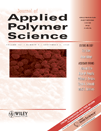Effect of charge density, molecular weight, and hydrophobicity on polycations adsorption and flocculation of polystyrene latices and silica
Abstract
Adsorption and flocculation behavior of two series of synthetic polycations was investigated in dispersions of silica and polystyrene latices with various particle size and surface charge densities. Polycations of the first series (polydiallyldimethyl ammonium chloride-PDADMAC) varied in molecular weight only, while polycations of the second series (derivatives of polymethacrylic acid) varied in both molecular weight and hydrophobicity. We have found that maximum adsorbed amount of high molecular weight PDADMAC on latex particles was nearly independent of the surface charge density when the particle size was comparable to the polymer coil dimensions in solution. Both low and high molecular weight PDADMACs were efficient flocculants, although significantly lower amounts of high molecular weight polyelectrolyte were required for the phase separation in the dispersions due to particles aggregation through “charge patch” mechanism. The increase of polymer hydrophobicity leads to higher adsorbed amounts and broadening of flocculation window by polycations of the second series on both substrates. However, no strong enhancement of segment–surface interactions on hydrophobic substrates was observed. Since formation of multilayers upon adsorption was also excluded, the difference in adsorption and flocculation behavior was related to the more compact conformation of hydrophobically associating derivatives in solution and at the interface. © 2006 Wiley Periodicals, Inc. J Appl Polym Sci 101: 3422–3429, 2006




